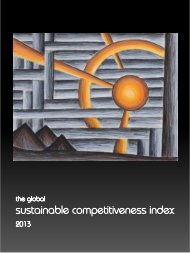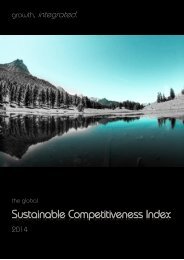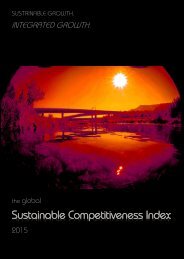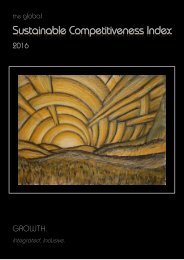The Global Sustainable Competitiveness Index 2019
Measuring competitiveness comprehensively: Sweden & Scandinavia tops, Germany #15, UK 17, US 34, China 37 in the Global Sustainable COmpetitiveness Index 2019
Measuring competitiveness comprehensively:
Sweden & Scandinavia tops, Germany #15, UK 17, US 34, China 37 in the Global Sustainable COmpetitiveness Index 2019
You also want an ePaper? Increase the reach of your titles
YUMPU automatically turns print PDFs into web optimized ePapers that Google loves.
Methodology
Table of
Contents
8.2 Competitiveness Indicators
The sustainable competitiveness model is based on a pyramid, where each level
is required to support the next higher level. In the top-down direction, the
different levels of the pyramid have influence the state of the lower levels.
Natural Capital
The natural capital is the base of the pyramid, and is defined by the
characteristics of the given physical environment of a country. The natural
capital consists of a mixture of size, population, geography, climate, biodiversity
and availability of natural resources (renewable and non-renewable), as well as
the level of depletion/degradation of the available resources. The combination
of these factors and the level of depletion of the non-renewable resources due
to human activity and climate change represents the potential for sustaining a
prosperous livelihood for the population and the economy of a nation into the
future.
Indicators used encompass water, forest and biodiversity indicators, agricultural
indicators, land degradation and desertification, minerals and energy resources,
pollution indicators and depletion indicators.
Natural Capital Indicators
Fossil energy prevalence (% of total)
Renewable freshwater availability/capita
Electricity from hydropower (% )
Forest area (% of total)
Arable land (ha/capita)
Potential arable land (ha/capita)
Land degradation (% of total)
Land at risk of desertification
Extreme weather incidents
Mineral reserves (per GNI and capita)
Population density
Food Production Index
Endangered species
Energy self-sufficiency
Land area below 5 m (% of total)
Population living below 5m (% of total)
Average rainfall (mm)
Biodiversity Benefit Index (GEF)
Fertilizer consumption/ha
Tourist attractiveness
Ocean Health Index
Natural resource depletion (as percentage of GNI)
Resource Intensity
The more efficient a nation is using resources (natural, human, financial), the
more wealth the country is able to generate. In addition, higher efficiency means
smaller negative impacts of potential supply scarcity of resources (food, energy,
water, minerals). Higher efficiency is also equal to lower cost per production unit
throughout all sectors, private and public. Efficient use of resources and energy
is an indicator for a nation’s ability to maintain or improve living standard levels
both under a future business-as-usual Indicators used cover water usage and
intensity, energy usage, intensity and energy sources, climate change emissions
and intensity as well as certain raw material usage. However, global data
availability for raw materials consumption other than steel is limited and therefore
could not be included.
36








